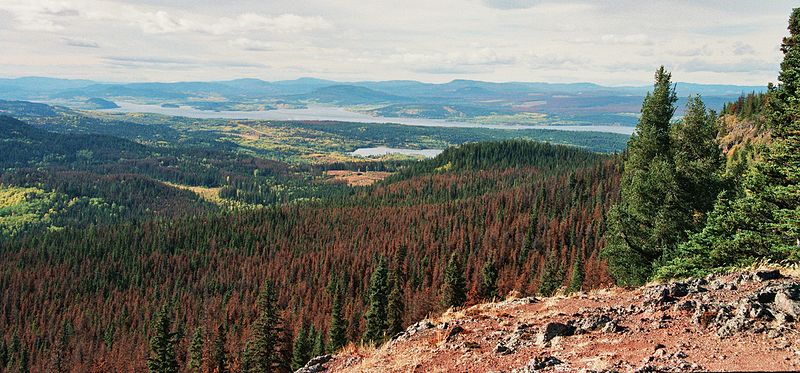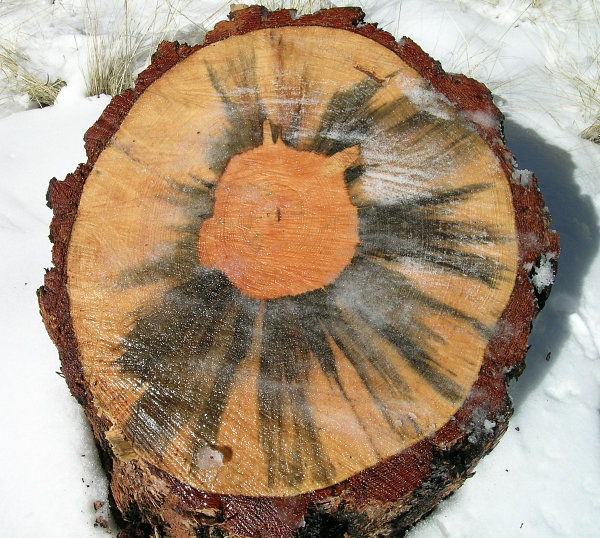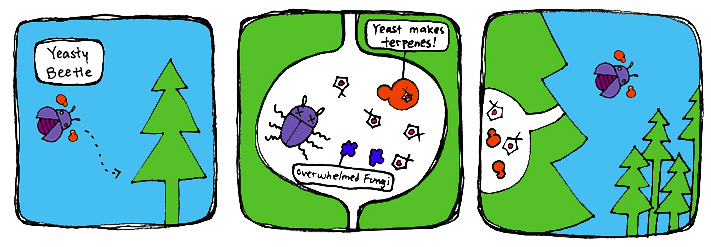Team:British Columbia/Story
From 2011.igem.org

Background
A video of the British Columbia Pine Beetle Epidemic up till 2010 produced by the UBC iGEM 2011 Beetle Epidemic Model.



From left to right: a view from Mount Fraser of dying pine trees turning red, a pine beetle, the effects of the bluestain fungus on a pine tree.
The mountain pine beetle (MPB) outbreak in British Columbia, Canada is the largest and most widespread of its kind in North America. This epidemic has killed millions of acres of lodgepole pine trees, endangering the forest health, which hosts a wide range of ecosystems, and threatening the economic, social, and cultural stability of our beautiful province. By 2013, according to the BC Ministry of Forests and Range, mortality of all merchantable pine trees is projected to be as high as 80%.
The blue stain fungus (Grosmannia clavigera) that lives in symbiosis with the MPB also plays a key role in the infestation. By laying their eggs, the beetles simultaneously introduce the blue stain fungus into the sapwood, which helps prevent the tree’s natural defences, a resin flow, from repelling and killing beetles. Thus, both the beetle and fungus are able to overcome the tree’s defences and colonize the insides of the tree. The fungus cuts off water and nutrient transport within the tree while beetle larvae feed off the tree. Within a year, the pine tree will die from lack of water and nutrient transport and its needles will turn red. Mature MPB will leave the dying tree and move on to the next host tree. In the years following the attack, the tree will turn gray with very little foliage. Most of this wood is unsalvageable due to the bluish-black stain left behind on the wood by the fungi. With vast amount of pines being killed, this has also become a fire hazard for BC. The MPB have always been present in nature and have never been a problem until the beginning of this century. Recent climate changes has resulted in warmer winters which has permitted the prolonged survival of these beetles during the winter. Therefore, its population has grown substantially over the past 15 years. The government of Canada and BC’s Ministry of Forestry have already committed over $956 million dollars to mitigate the spread of the MPB to more pine trees in BC. However, no permanent solution has been found so far.
A tremendous amount of research has been invested in studying the genetics and molecular systems of the three players involved: the pine tree, the MPB, and the blue stain fungus. Interestingly, it was noted that not all pine trees in the outbreak area are infested with the MPB. This begs the question: why do some trees not get attacked by the MPB? Researchers have explored this question through genomic studies comparing attacked pines to those left unharmed. A greater expression of genes related to monoterpene production was observed in unharmed trees. In nature, these monoterpenes, a class within the family of terpeniods, are synthesized and secreted by trees as a defence mechanism against insect and fungi infestation within the tree. Despite this finding, the bluestain fungus has also adapted to the tree’s natural defenses by degrading these terpenoids and removing it from its system, allowing the fungi and the MPB to survive under these toxic conditions. However, researchers have postulated that the blue stain fungus is able to evade these conditions only by attacking stressed trees, where levels of monoterpenes produced are less than normal and thus more susceptible to attacks.
For more resources on the pine beetle infestation, here is an interactive Mountain Pine Beetle Student Resource provided by Ministry of Forest: Pine Beetles in British Columbia, Canadian Forest Service, BC Market Outreach Network, and the COFI Mountain Pine Beetle Task Force.
The Beetle's Strategy
The mountain pine beetle lives in symbiosis with the bluestain fungus which is able to break down monoterpenes produced by the tree to deter insect attacks. Their relationship allows the mountain pine beetle to avoid the toxic effects of the monoterpenes, while the bluestain fungus is carried inside the tree where it can happily grow and colonize. The beetles lay their larvae that consume the bluestain fungus for nutrients. Once the larvae grow into adult beetles, they carry the bluestain fungus and infect other trees. Meanwhile, the trees turn red and die because the bluestain fungus blocks transport of water and nutrients throughout the tree. Over the last decade, the pine beetle-bluestain fungus epidemic has spread rapidly through North American pine forests, causing mass destruction to forest health and reliant ecosystems.
Our Theoretical Strategy: iSynthase Trapbox
To restore the levels of monoterpenes in the trees, we propose the introduction of our monoterpene-producing yeast into the environment. Like the beetle's strategy, we will introduce our yeast via trap boxes attracting the beetles by artificial beetle pheromones. Along with the pine beetle infestation, the yeast will be carried by the pine beetle into the trees. Previous studies have shown inhibition of bluestain fungus growth upon interaction with certain concentrations of monoterpenes. Assuming that our yeast does inhibit the growth of bluestain fungus due to the monoterpenes produced, this will also subdue the mountain pine beetle population that depends on the blue-stain fungus. We predict that the spread of our yeast will be similar to the pine-beetle infestation, with the hope that it will spread from beetle to beetle. Therefore, the spread of our yeast product will fall once pine-beetle population declines.
 "
"

